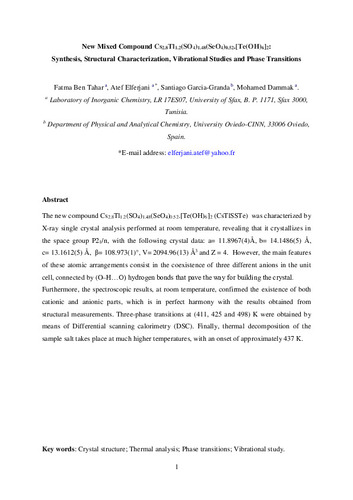New Mixed Compound Cs2.8Tl1.2(SO4)1.48(SeO4)0.52.[Te(OH)6]2: Synthesis, Structural Characterization, Vibrational Studies and Phase Transitions
Autor(es) y otros:
Palabra(s) clave:
Crystal structure; Thermal analysis; Phase transitions; Vibrational study.
Fecha de publicación:
Versión del editor:
Citación:
Resumen:
The new compound Cs2.8Tl1.2(SO4)1.48(SeO4)0.52.[Te(OH)6]2 (CsTlSSTe) was characterized by X-ray single crystal analysis performed at room temperature, revealing that it crystallizes in the space group P21/n, with the following crystal data: a= 11.8967(4)Å, b= 14.1486(5) Å, c= 13.1612(5) Å, β= 108.973(1)°, V= 2094.96(13) Å3 and Z = 4. However, the main features of these atomic arrangements consist in the coexistence of three different anions in the unit cell, connected by (O–H…O) hydrogen bonds that pave the way for building the crystal. Furthermore, the spectroscopic results, at room temperature, confirmed the existence of both cationic and anionic parts, which is in perfect harmony with the results obtained from structural measurements. Three-phase transitions at (411, 425 and 498) K were obtained by means of Differential scanning calorimetry (DSC). Finally, thermal decomposition of the sample salt takes place at much higher temperatures, with an onset of approximately 437 K.
The new compound Cs2.8Tl1.2(SO4)1.48(SeO4)0.52.[Te(OH)6]2 (CsTlSSTe) was characterized by X-ray single crystal analysis performed at room temperature, revealing that it crystallizes in the space group P21/n, with the following crystal data: a= 11.8967(4)Å, b= 14.1486(5) Å, c= 13.1612(5) Å, β= 108.973(1)°, V= 2094.96(13) Å3 and Z = 4. However, the main features of these atomic arrangements consist in the coexistence of three different anions in the unit cell, connected by (O–H…O) hydrogen bonds that pave the way for building the crystal. Furthermore, the spectroscopic results, at room temperature, confirmed the existence of both cationic and anionic parts, which is in perfect harmony with the results obtained from structural measurements. Three-phase transitions at (411, 425 and 498) K were obtained by means of Differential scanning calorimetry (DSC). Finally, thermal decomposition of the sample salt takes place at much higher temperatures, with an onset of approximately 437 K.
ISSN:
Colecciones
- Artículos [36139]
- Química Física y Analítica [597]
Ficheros en el ítem





